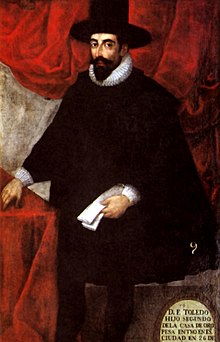Francisco Álvarez de Toledo | |
|---|---|
 | |
| 5th Viceroy of Peru | |
| In office November 30, 1569 – May 1, 1581 | |
| Monarch | Philip II of Spain |
| Preceded by | Lope García de Castro |
| Succeeded by | Martín Enríquez de Almanza |
| Personal details | |
| Born | 10 July 1515 Oropesa, Crown of Castile |
| Died | 21 April 1582 (aged 66) Escalona, Crown of Castile |
| Profession | politician and soldier |
| Military service | |
| Battles/wars | |
Francisco Álvarez de Toledo (Oropesa, 10 July 1515 – Escalona, 21 April 1582), also known as The Viceroyal Solon,[1] was an aristocrat and soldier of the Kingdom of Spain and the fifth Viceroy of Peru. Often regarded as the "best of Peru's viceroys",[2] he is as often denounced for the negative impact his administration had on the Indigenous peoples of Peru.[3]
Toledo brought stability to a tumultuous viceroyalty of Spain and enacted administrative policies which changed the character of Spanish colonial rule and the relationship between the Indigenous peoples of the Andes and their Spanish overlords.[4] With a policy called "reductions", Toledo forcibly relocated many of the Indigenous peoples of Peru and Bolivia into new settlements in order to enforce their Christianization, collect tributes and taxes, and gather Indigenous labor to work in mines and other Spanish enterprises. He has been condemned for the reductions, expanding the forced labor demanded of the Indigenous peoples under the mit'a of the Inca Empire, and executing Túpac Amaru, the last Inca chief of the Neo-Inca State in Vilcabamba.[5]
Toledo held the position of viceroy from November 30, 1569, until 1 May 1581, a total of eleven years and five months. He has been praised as the "supreme organizer" of the immense viceroyalty, giving it a legal structure and strengthening institutions by which the Spanish colony functioned for more than two hundred years.[6] Scholar John Hemming described Toledo as "one of the world's great colonial administrators". He also described him as "honest and honorable but cold and unfeeling...autocratic" and "with the temperament of an ascetic."[7]
- ^ This was the name given by Antonio de León Pinelo: "Solón del Perú".
- ^ Tantaleán Arbulú, Javier. El Virrey Francisco de Toledo y su tiempo. 2 T. Universidad de San Martín de Porres. Lima. 2011. http://www.librosperuanos.com/libros/detalle/11817/El-Virrey-Francisco-de-Toledo-y-su-tiempo.-2-T
- ^ Wightman, Ann M. (1990). Indigenous Migration and Social Change: The Forasteros of Cuzco, 1570-1720. Durham, NC: Duke University Press. pp. 13, 15. ISBN 9780822382843.
- ^ Viceroyalty of Peru|historical area, South America", https://www.britannica.com/place/Viceroyalty=of=Peru#ref76658, accessed 6 July 2016
- ^ Luis E. Valcárcel: The viceroy Toledo, great tyrant of Peru: a historical review. Lima, National Museum Press, 1940.
- ^ Roberto Levillier: Don Francisco de Toledo, Peru supreme organizer. His life, his work [1515–1582]. Buenos Aires, Espasa-Calpe, 1935 to 1942
- ^ Hemming 1970, pp. 391–393.